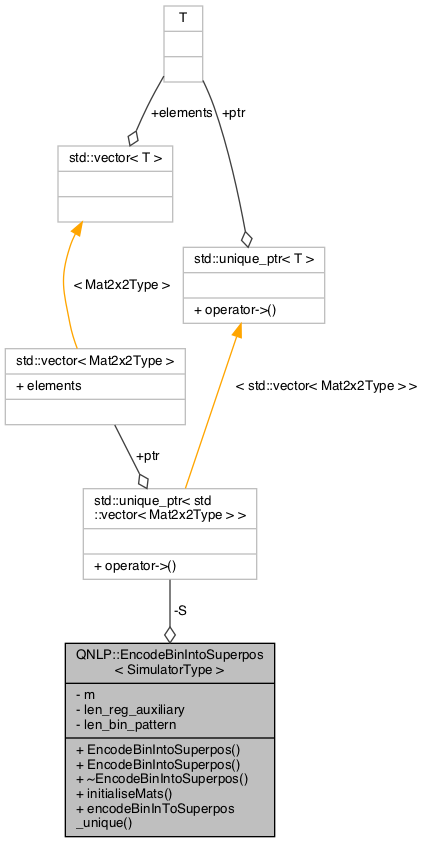Definition of class to encode a binary string represented by an integer into a superposition of states. More...
#include <bin_into_superpos.hpp>

Public Member Functions | |
| EncodeBinIntoSuperpos ()=delete | |
| Construct a new object instance to encode a binary string into a superposition (disabled) More... | |
| EncodeBinIntoSuperpos (const std::size_t num_bin_patterns, const std::size_t len_bin_pattern_) | |
| Construct a new object instance to encode a binary string into a superposition. More... | |
| ~EncodeBinIntoSuperpos () | |
| Destroy the Encode Bin Into Superpos object. More... | |
| void | initialiseMats () |
| Initialiser of the encoder (define the required PauliX and the unitary matrix S) More... | |
| void | encodeBinInToSuperpos_unique (SimulatorType &qSim, const std::vector< std::size_t > ®_memory, const std::vector< std::size_t > ®_auxiliary, const std::vector< std::size_t > &bin_patterns) |
| Encodes each element of inputted vector as a binary string in a superpostiion of states. Requires each binary input to be unique. More... | |
Private Types | |
| using | Mat2x2Type = decltype(std::declval< SimulatorType >().getGateX()) |
Private Attributes | |
| std::unique_ptr< std::vector< Mat2x2Type > > | S |
| std::size_t | m |
| std::size_t | len_reg_auxiliary |
| std::size_t | len_bin_pattern |
Detailed Description
template<class SimulatorType>
class QNLP::EncodeBinIntoSuperpos< SimulatorType >
Definition of class to encode a binary string represented by an integer into a superposition of states.
- Template Parameters
-
SimulatorType Class simulator type
Definition at line 36 of file bin_into_superpos.hpp.
Member Typedef Documentation
◆ Mat2x2Type
|
private |
Definition at line 38 of file bin_into_superpos.hpp.
Constructor & Destructor Documentation
◆ EncodeBinIntoSuperpos() [1/2]
|
delete |
Construct a new object instance to encode a binary string into a superposition (disabled)
◆ EncodeBinIntoSuperpos() [2/2]
|
inline |
Construct a new object instance to encode a binary string into a superposition.
- Parameters
-
num_bin_patterns Number of binary patterns to encode len_bin_pattern_ Length of the binary patterns being encoded
Definition at line 56 of file bin_into_superpos.hpp.
References QNLP::EncodeBinIntoSuperpos< SimulatorType >::initialiseMats(), QNLP::EncodeBinIntoSuperpos< SimulatorType >::len_bin_pattern, and QNLP::EncodeBinIntoSuperpos< SimulatorType >::m.

◆ ~EncodeBinIntoSuperpos()
|
inline |
Destroy the Encode Bin Into Superpos object.
Definition at line 67 of file bin_into_superpos.hpp.
Member Function Documentation
◆ encodeBinInToSuperpos_unique()
|
inline |
Encodes each element of inputted vector as a binary string in a superpostiion of states. Requires each binary input to be unique.
- Parameters
-
qReg Qubit register reg_memory A vector containing the indices of the qubits of the memory register. reg_auxiliary A vector containing the indices of the qubits of the auxiliary register. Vector of non-negative integers which represent the inputted binary patters that are to be encoded.
Definition at line 112 of file bin_into_superpos.hpp.
References IS_SET, QNLP::EncodeBinIntoSuperpos< SimulatorType >::len_bin_pattern, QNLP::EncodeBinIntoSuperpos< SimulatorType >::len_reg_auxiliary, QNLP::EncodeBinIntoSuperpos< SimulatorType >::m, QNLP_Python_MPI::reg_auxiliary, QNLP_EndToEnd_MPI::reg_memory, and QNLP::EncodeBinIntoSuperpos< SimulatorType >::S.
Referenced by QNLP::SimulatorGeneral< IntelSimulator >::encodeBinToSuperpos_unique(), and TEST_CASE().

◆ initialiseMats()
|
inline |
Initialiser of the encoder (define the required PauliX and the unitary matrix S)
Definition at line 74 of file bin_into_superpos.hpp.
References QNLP::EncodeBinIntoSuperpos< SimulatorType >::m, and QNLP::EncodeBinIntoSuperpos< SimulatorType >::S.
Referenced by QNLP::EncodeBinIntoSuperpos< SimulatorType >::EncodeBinIntoSuperpos().

Field Documentation
◆ len_bin_pattern
|
private |
Definition at line 41 of file bin_into_superpos.hpp.
Referenced by QNLP::EncodeBinIntoSuperpos< SimulatorType >::EncodeBinIntoSuperpos(), and QNLP::EncodeBinIntoSuperpos< SimulatorType >::encodeBinInToSuperpos_unique().
◆ len_reg_auxiliary
|
private |
Definition at line 41 of file bin_into_superpos.hpp.
Referenced by QNLP::EncodeBinIntoSuperpos< SimulatorType >::encodeBinInToSuperpos_unique().
◆ m
|
private |
◆ S
|
private |
Definition at line 40 of file bin_into_superpos.hpp.
Referenced by QNLP::EncodeBinIntoSuperpos< SimulatorType >::encodeBinInToSuperpos_unique(), and QNLP::EncodeBinIntoSuperpos< SimulatorType >::initialiseMats().
The documentation for this class was generated from the following file:
- /Users/mlxd/Desktop/intel-qnlp-rc2/modules/encoding/bin_into_superpos.hpp
